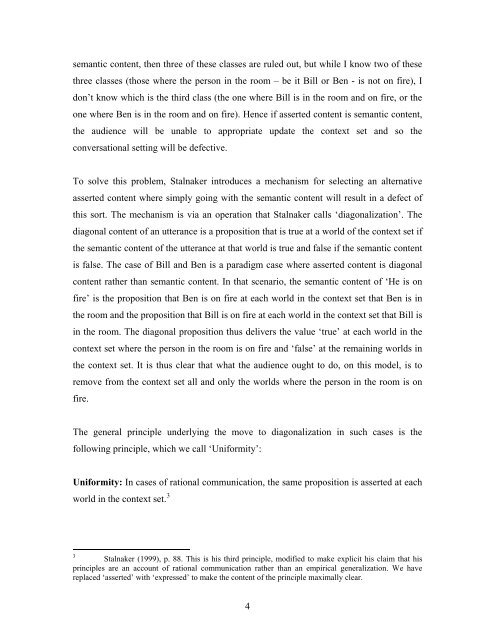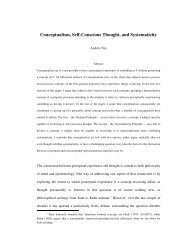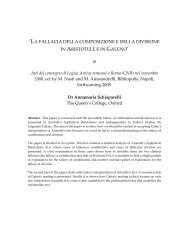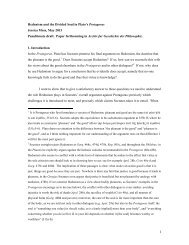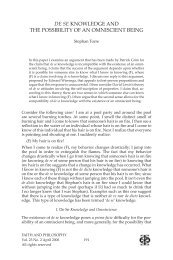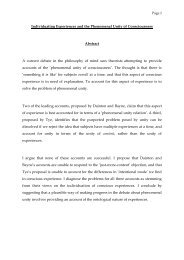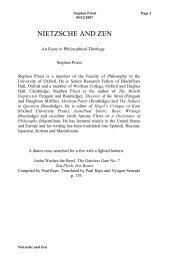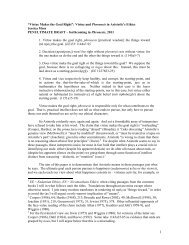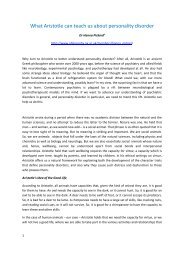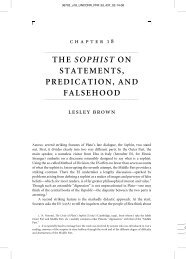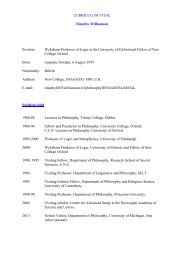In 'Assertion', Robert Stalnaker distinguishes between the sema
In 'Assertion', Robert Stalnaker distinguishes between the sema
In 'Assertion', Robert Stalnaker distinguishes between the sema
You also want an ePaper? Increase the reach of your titles
YUMPU automatically turns print PDFs into web optimized ePapers that Google loves.
<strong>sema</strong>ntic content, <strong>the</strong>n three of <strong>the</strong>se classes are ruled out, but while I know two of <strong>the</strong>se<br />
three classes (those where <strong>the</strong> person in <strong>the</strong> room – be it Bill or Ben - is not on fire), I<br />
don’t know which is <strong>the</strong> third class (<strong>the</strong> one where Bill is in <strong>the</strong> room and on fire, or <strong>the</strong><br />
one where Ben is in <strong>the</strong> room and on fire). Hence if asserted content is <strong>sema</strong>ntic content,<br />
<strong>the</strong> audience will be unable to appropriate update <strong>the</strong> context set and so <strong>the</strong><br />
conversational setting will be defective.<br />
To solve this problem, <strong>Stalnaker</strong> introduces a mechanism for selecting an alternative<br />
asserted content where simply going with <strong>the</strong> <strong>sema</strong>ntic content will result in a defect of<br />
this sort. The mechanism is via an operation that <strong>Stalnaker</strong> calls ‘diagonalization’. The<br />
diagonal content of an utterance is a proposition that is true at a world of <strong>the</strong> context set if<br />
<strong>the</strong> <strong>sema</strong>ntic content of <strong>the</strong> utterance at that world is true and false if <strong>the</strong> <strong>sema</strong>ntic content<br />
is false. The case of Bill and Ben is a paradigm case where asserted content is diagonal<br />
content ra<strong>the</strong>r than <strong>sema</strong>ntic content. <strong>In</strong> that scenario, <strong>the</strong> <strong>sema</strong>ntic content of ‘He is on<br />
fire’ is <strong>the</strong> proposition that Ben is on fire at each world in <strong>the</strong> context set that Ben is in<br />
<strong>the</strong> room and <strong>the</strong> proposition that Bill is on fire at each world in <strong>the</strong> context set that Bill is<br />
in <strong>the</strong> room. The diagonal proposition thus delivers <strong>the</strong> value ‘true’ at each world in <strong>the</strong><br />
context set where <strong>the</strong> person in <strong>the</strong> room is on fire and ‘false’ at <strong>the</strong> remaining worlds in<br />
<strong>the</strong> context set. It is thus clear that what <strong>the</strong> audience ought to do, on this model, is to<br />
remove from <strong>the</strong> context set all and only <strong>the</strong> worlds where <strong>the</strong> person in <strong>the</strong> room is on<br />
fire.<br />
The general principle underlying <strong>the</strong> move to diagonalization in such cases is <strong>the</strong><br />
following principle, which we call ‘Uniformity’:<br />
Uniformity: <strong>In</strong> cases of rational communication, <strong>the</strong> same proposition is asserted at each<br />
world in <strong>the</strong> context set. 3<br />
3<br />
<strong>Stalnaker</strong> (1999), p. 88. This is his third principle, modified to make explicit his claim that his<br />
principles are an account of rational communication ra<strong>the</strong>r than an empirical generalization. We have<br />
replaced ‘asserted’ with ‘expressed’ to make <strong>the</strong> content of <strong>the</strong> principle maximally clear.<br />
4


